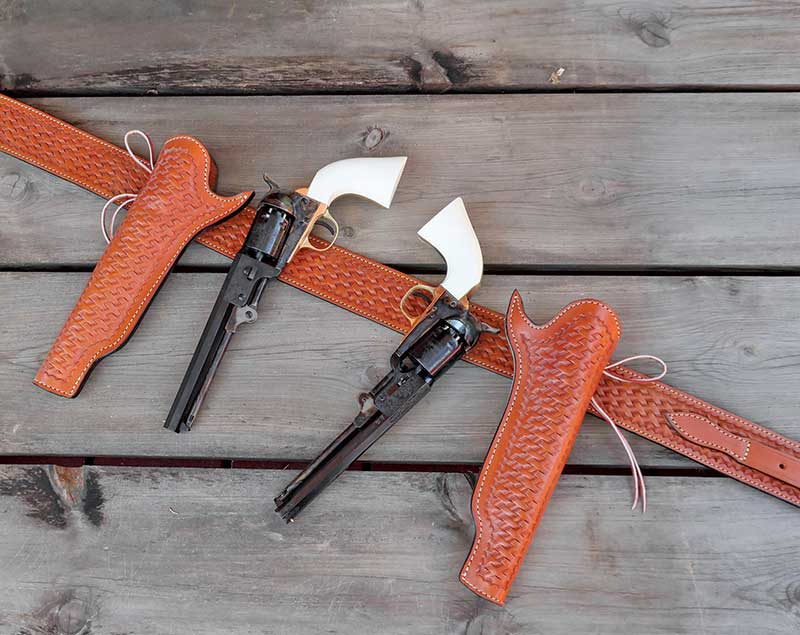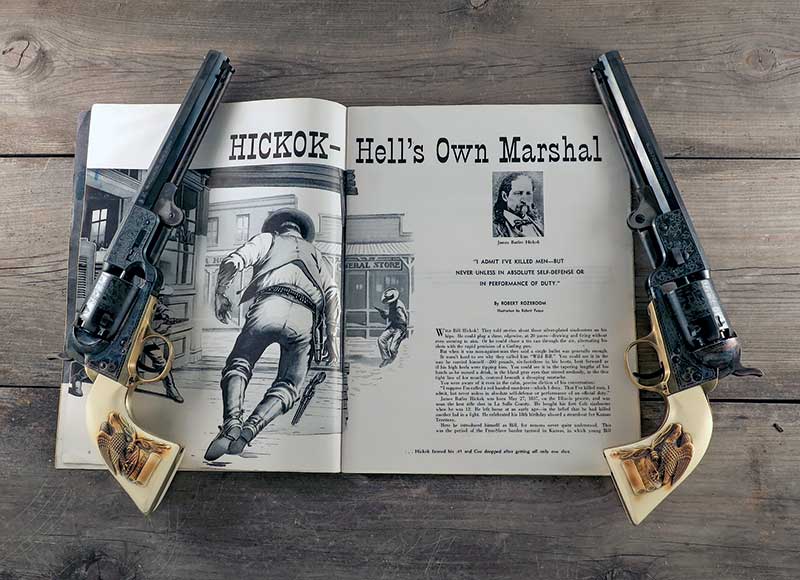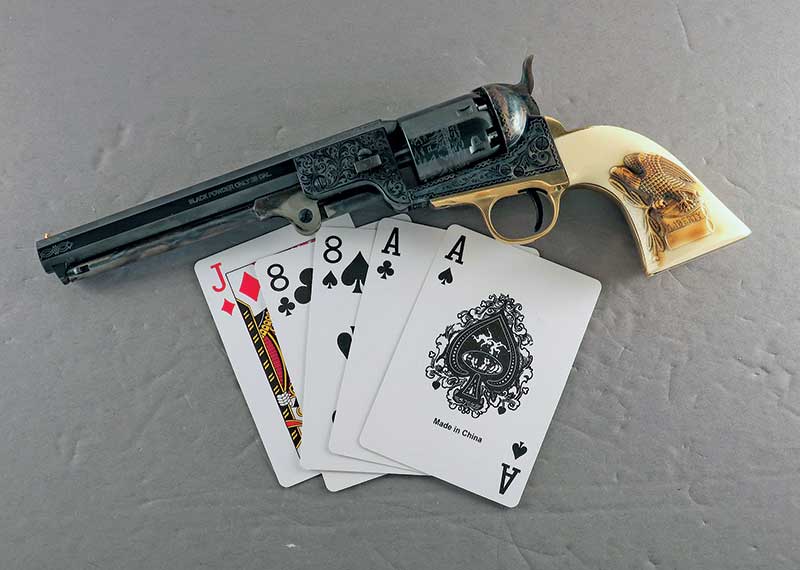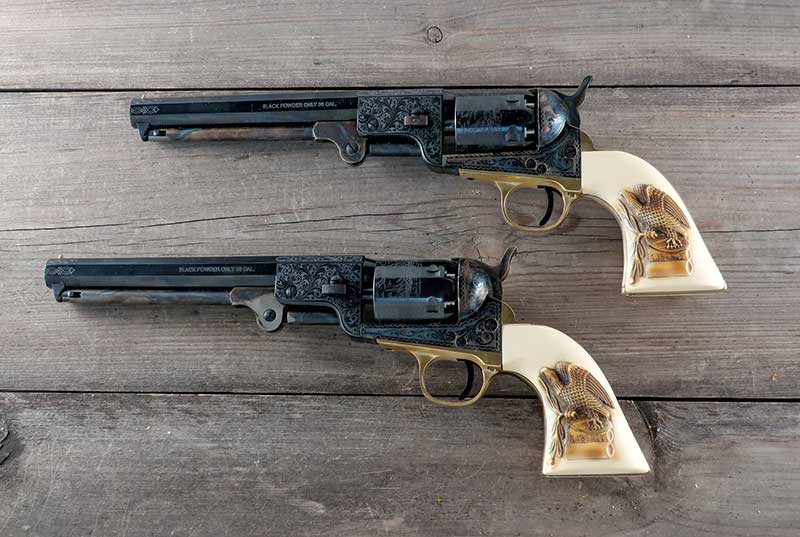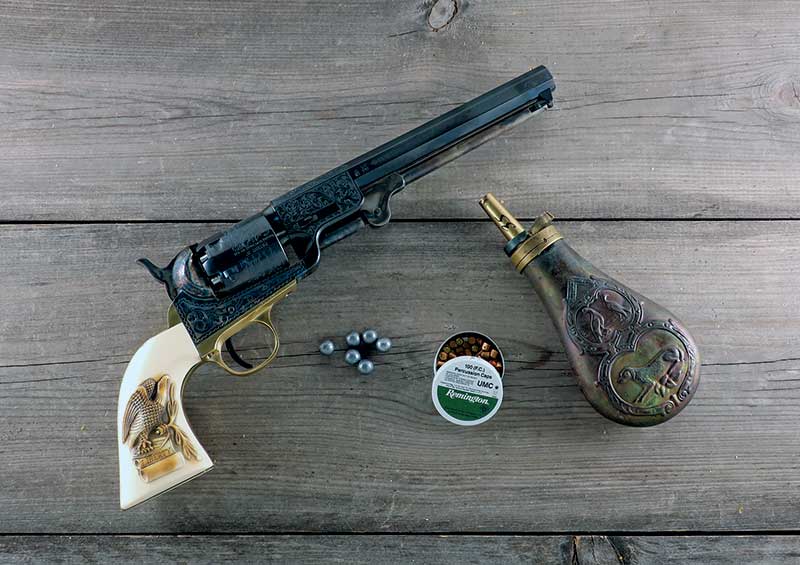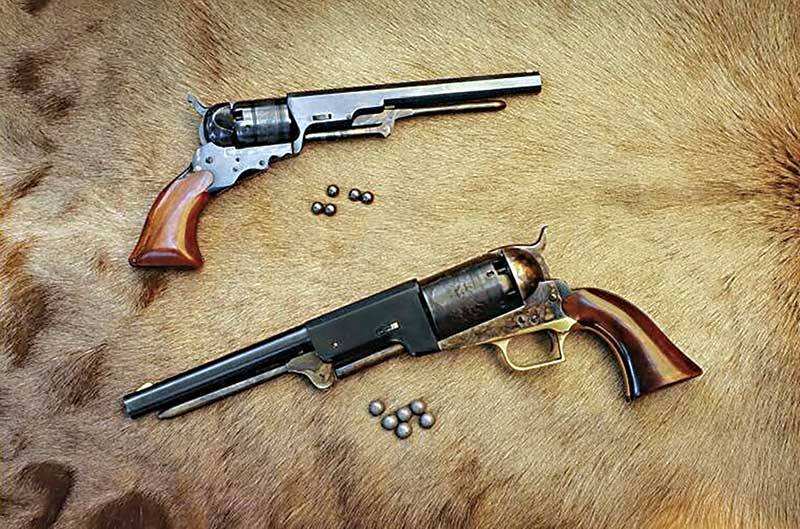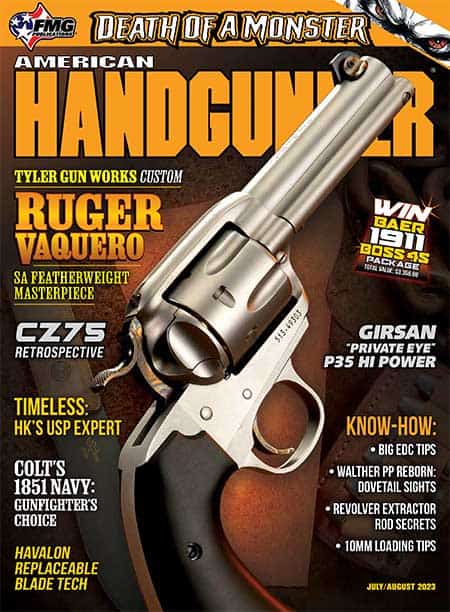Colt's 1851 Navy:
The Gunfighter's Choice
Power notwithstanding, Colt Walkers and Dragoons were much too large, heavy and cumbersome to be carried in a holster on the belt, so eventually, Colt went the complete opposite direction and brought out a series of Pocket Pistols, which were five-shot .31 caliber and easily carried concealed on the person. Today these are known mainly as the Baby Dragoon, the Wells Fargo, and the most popular and the highest-selling Colt firearm during the percussion era, the 1849 Pocket Pistol.
With both ends of the spectrum covered, Colt now looked at what would turn out to be the first sixgun, which combined both power and portability, and would usher in the age of the gunfighter. That sixgun was the 1851 Navy .36. No, it was not as powerful as the Dragoons. However, it was adequately so, and with its 7½” octagon barrel was about half of the weight of the Walkers and Dragoons. The basic platform of the 1851 Navy would be used to build the 1860 Army, which featured the streamlined barrel and loading lever. Then, this was used to develop the 1861 Navy .36, which featured the same style barrel and loading lever.
In the first issue of GUNS Magazine in January 1955, Robert Rozeboom wrote an article, “Hickok — Hell’s Own Marshall.” What follows is a quote from that article:
“Wild Bill Hickok! They told stories about those silver-plated six-shooters on his hips. He could plug an edgewise dime at 20 paces — drawing and firing without seeming to aim. Or he could chase a tin can through the air, alternating his shots with the rapid precision of a Gatling gun. But when it was man-against-man, they said a single bullet was generally enough. It wasn’t hard to see why they called him Wild Bill; you could see it in the way he carried himself — 200 lbs., six-foot-three in his boots, bent forward as if his high heels were tipping him. You could see it in the tapering lengths of his hands as he nursed a drink, and the bland gray eyes that stirred restlessly, in the thin tight line of his mouth, centered beneath the drooping mustache. You are aware of it even in the calm, precise diction of his conversation as he said, ‘I suppose I’m called a red-handed murderer — which I deny. That I’ve killed men, I admit, but never unless an absolute self-defense or performance of an official duty.’ Were Hickok’s feats with the percussion revolver real or something more akin to the Hollywood legend? You can decide on your own whether or not you want to believe these marksmanship feats using a percussion revolver.”
The lengthy article provides much information about Wild Bill’s life, including the famous shootout between him and Dave Tutt. The story goes that Tutt had grabbed Bill’s watch during a poker game for nonpayment of his debts. Hickok warned him not to wear that watch, which is exactly what Tutt did, stepping out on Main Street the next day and taunting Hickok. This was a real gunfight, not the Hollywood style. They did not meet on Main Street at 12 paces, with both going for their sixguns. They did not wear metal-lined low-slung holsters such as those used by Matt Dillon and Paladin, which allowed amazing speed but only in the movies. The story is that Tutt started firing from 75 yards away, and Hickok calmly raised his pistol and shot Tutt through the heart.
The prevailing wisdom is that Hickok used one of his .36 Navy Colts. However, the article in that January 1955 issue of GUNS gives a different story. The author claims Tutt was carrying a brand-new .36 Navy while Hickok used a .44 Dragoon. There may be other references to this, but this is the only one I have ever encountered.
Consider this. Hickok was a town-dweller to the point it was said he never owned a horse. He spent his time sitting at the poker tables or walking around town, which tells me he would much rather have a .36 Navy than the 4-lb. .44 Dragoon. We do know Hickok and the .36 Navy Colts are matched together by history. Was James Butler Hickok, who early on took the name of Bill and then Wild Bill, the nice guy portrayed by Guy Madison or a bloodthirsty killer? The truth is probably somewhere in between.
Modern Day Navy’s
Thanks to Italian manufacturers, all of the original Colt Percussion Pistols are now available in replica form. I have examples of the .36 Navy from both Pietta and Uberti. My “Hickok” .36 Navy Colts are a pair of engraved Pietta blued finish with brass grip frames. The grip frames have been fitted with Buffalo Brothers’ version of the antique ivory carved Hickok Eagle.
Today’s modern replicas are a far cry from those that first started appearing in the 1950s. Whichever the manufacturer, Pietta or Uberti, one can expect a quality piece with excellent fit and finish. Just like any production sixguns this side of Freedom Arms, they are not perfect. Perfection requires a much more significant expenditure of funds than these replicas. A few minor things need to be done to any Italian replica, all of which I can handle myself.
Replica Tweaks
I routinely replace the factory cones/nipples with stainless steel Slix-Shot nipples from Slix-Springs. These high-quality nipples are shaped to accept Remington #10 or Speer #11 caps, and they also are vented on the side, which helps prevent hammer blowback — a significant cause of cap jams.
Any replica I acquire is completely disassembled, all parts are totally cleaned of factory oil, and I then use hones, stones and small files to remove any burrs that may have been left behind. Production has come to the point where burrs are not all that prevalent. I especially check out the slot in the frame, which accepts the hand to ensure smoothness. I also hone the sides of the hammer, hand, bolt and trigger to ensure smoothness.
I do two things to the hammer. The tiny slot on the top of the hammer, which serves as a rear sight, is opened with a cut-off wheel on a Dremel to give a better sight picture. Then I smooth off the face of the hammer where it hits the cap and remove any sharp edges in the slot on the hammer face, which fits over the safety pin on the back of the cylinder. This also serves to prevent cap jams as it reduces the tendency of the hammer to grab a fired cap. Once all of this has been accomplished, I lubricate moving parts with a quality gun grease, not oil, and coat the arbor, which accepts the cylinder also with grease. This helps to keep the revolver functioning and resists the fouling afforded by black powder or black powder substitutes.
My Navy Loads
Most of my loads for the .36 Navy are assembled with the 0.375″ swaged round ball, whether from Hornady or Speer, which weigh approximately 90 grains. I measure all loads using a black powder volume measure. The measured amount of powder desired is placed in the cylinder chamber, a felt wad is placed over the powder, and then the round ball is seated using the loading lever on the Navy. To help keep things clean, I fill out the cylinder in front of the ball with a lube such as 50:50 beeswax and mutton tallow. This is especially important to minimize fouling with top loads, as there is no room for a wad between powder and bullet.
Typical results using FFFg black powder with a felt wad between powder and ball are 15 grains for 725 fps, 20 grains for 855 fps, and 25 grains tops out just over 900 fps. Switching to Hodgdon’s black powder substitute, Pyrodex, results in just over 800 fps with 20 grains, while 25 grains gets us very close to 1,000 fps. By today’s standards, these would not be considered very powerful loads; however, they seemed to work very well in the 19th century.
Maintenance And Carry
One of the drawbacks of shooting percussion pistols is that they must be thoroughly cleaned after shooting. It is said Hickok emptied both of his sixguns by firing them every morning and then putting in fresh loads. He would also have had to clean the cylinder and barrel daily to keep them from rusting or pitting.
Apparently, Hickok never even bothered with holsters, preferring to carry his pair of ivory-gripped Colts butt to the front first in a belt and then later in a sash around his waist. In all probability, he did not use the sixguns in cross-draw fashion, but rather with a twist or cavalry draw, grabbing the butt of the sixgun with a hand on the same side. Historically correct holsters, which are still a grand choice today, are known as the Slim Jim design. These typically carried the sixgun butt to the front, high on the belt, and out-of-the-way. They are both secure and easily assessable. Unlike the modern Hollywood Fast Draw Holster with metal lining in the shank and body and mounted on a heavy belt, the Slim Jim can be carried in comfort all day.
Even after the advent of the cartridge-firing S&W .44 and the Colt Single Action Army .45, Hickok stayed with his old cap-and-ball sixguns. He was still using his .36-caliber Colts when he was shot in the back of the head by Jack McCall. Hickok was playing poker at the time and died with two pairs in his hands. There is not a lot of agreement on what his fifth card was. I have seen Museum displays with black aces and eights and both the Jack of diamonds and the Queen of hearts as the fifth card. The cards have come to be known as the Dead Man’s Hand.


